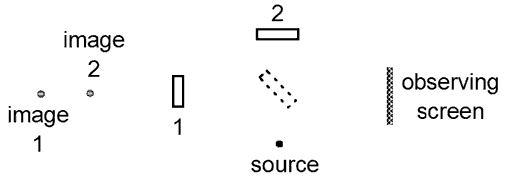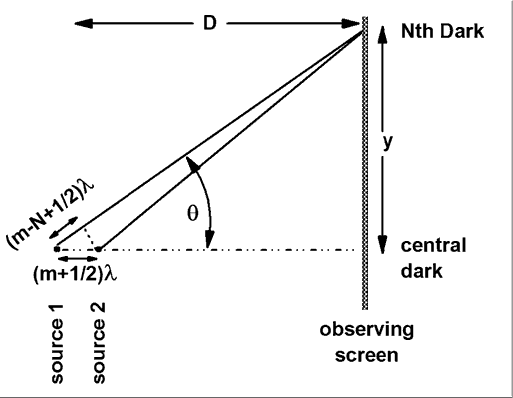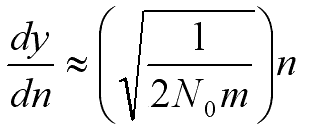Experiment of The Month
Interferometer Phase Shift Calibration
David Parks built a prototype optical cell with the intent of studying density variations throughout a volume of gas inside the cell. The cell is placed in one arm of a Michelson interferometer. If we assume that the angle of incidence on the cell is small enough that refraction may be ignored, the cell simply changes the path length on its leg of the interferometer. The setup is shown below.

For analysis we use the usual pair of virtual images of a point source, formed by mirrors 1 and 2, as well as the beam splitter (dotted rectangle). The interference pattern is determined by the geometry shown below.

The virtual images are represented as two coherent point sources, set apart so that along their axis of separation, a dark spot appears at the screen. The excess path for the Nth dark spot is given by

For small angles, this implies

for large N0 , and in turn

That is, for large N, the fringe spacing is approximately constant. If now a cell containing a different gas is inserted into the path from source 1, the fringes at large N0 will still be spaced at roughly constant intervals.
N0 will change as the gas is removed with a vacuum pump. The change in N0 can be monitored by counting the fringes as they move past a reference point. That change can be used to determine the index of refraction of the gas as a function of density of the gas.
If the density of the gas is (for example) larger at the bottom of the cell, it is difficult to predict the effect on the pattern, because with a distributed source, light reaches an observation point along a variety of paths.
Study of density gradients calls for a narrow beam of light, passing through only one part of the cell. After using a sodium lamp to align the Michelson mirrors to display the central spot at the observation plane, a laser replaced the lamp, as shown at the right. The brass cell is mounted to the moving table of a micrometer driven translational stage (at the right side of the photo).
The cell is moved vertically through the beam and changes in path length register as changes in the interference signal at the detector. In order to calibrate the cell, the effect of raising it with no density variation must be determined.
To this end the cell was filled with water to give good sensitivity to variations in the separation of the cell windows. Scans indicated that the window separation increased by about 3 wavelengths in water as the beam scanned from bottom to top.
-
Contact Information
Contact Number: 717-871-4297
Email: physics@millersville.edu